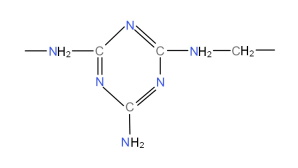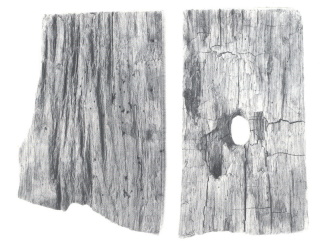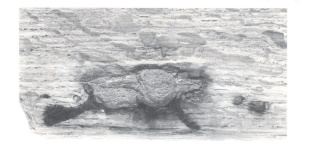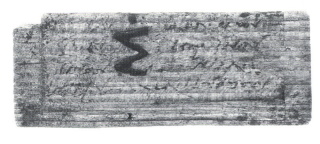Current developments in the preservation of archaeological wet wood with melamine/amino resins at the Roemisch-Germanisches Zentralmuseum
1. Historical review
A. Haas and H. Müller-Beck of the Bern Historical Museum developed a method to preserve archaeological wet wood with water- soluble melamine resin over fifty years ago. It became known as the »Arigal C method« 1. When the production of Arigal-C was stopped in the seventies, the manufacturer2 offered comparable melamine resins under the trading name »Lyofix« that have been successfully used by us, among others3. At the beginning of the nineties, Roman-Germanic Central Museum - RGZM was instrumental in establishing contacts with BASF scientists 4 who, since then, have helped us in every possible way to optimise the preservation of archaeological wet wood with amino resins. The name of the melamine resin currently in use at our Institute is »Kauramin®impregnating resin 800« 5.
2. Properties of Kauramin 800
The melamine resins that were first introduced in Germany in 1936 are used in a broad range of industries (e.g. wood, furniture, fabrics, or as leather auxiliaries and soil conditioners). The resins are well adapted to the preservation of archaeological wet wood due to their solubility in water, their low viscosity (150-200 m Pa.s), the small size of their molecules (1 melamine molecule = 5 Ångström) and thus, their good penetration behaviour, among their most important properties. Hardening, or more accurately polycondensation, is the three-dimensional irreversible cross linkage of the resin. It is accelerated by acid (i.e. a low pH-value) and increased temperature. The resin dry content is approximately 70 %, its active ingredient part 90 %6.
Kauramin 800 differs from the Arigal and Lyofix types among other things through the complete alcohol etherification which slows down the increase in viscosity and prolongs the life of a soaking bath up to 14 months. In practical terms, this means that the soaking baths no longer turn bad and that spontaneous resin deposits on the wood surface no longer occur, as was to be feared with Lyofix. Usual, amino resins become brittle to hard when they harden. Kauramin 800 has been modified with ethylene glycol to give the resin more elasticity. As a result, the preserved wood pieces show less transverse cracks due to brittleness than was the case with the Lyofix preservation.
3. Preservation procedure at the RGZM
The following preservation procedure has given good results at the Roman-Germanic Central Museum in the course of over 35 years of experience in the use of melamine resins in the treatment of wet wood.
Wet wood cleaning
The object is put into deionised water after the wood surface has been mechanically cleaned, in order to remove organic and inorganic acid rests (mostly in the case of oak and sewage wood). This is necessary because Kauramin 800 is a melamine resin that hardens in acid;
Impurities in a soaking bath (e.g. humic acid in wood) reduce its life and trigger the hardening process too early. The vats are covered with black film in order to protect the cleansing bath from light and air. This simple but efficient method, coupled with regular renewal of the deionised water, renders an addition of biocides superfluous. The cleansing process is monitored a) by measurement of the pH-value (the cleansing bath should tend as much as possible to a neutral pH-value) and b) by measurement of the conductivity (the cleansing process should be carried on as long as soil salts can be extracted). The duration of the cleansing process depends on many factors: wood type, wood size, deterioration, composition of the soil, duration of storage in the ground, relation between wood volume and water quantity and frequency of water renewal. 1 - 5 months are usually necessary.
The subsequent treatment with melamine resin takes place at room temperature (heatable vessels are not necessary). Every watertight vessel can be used. It is possible to build plywood vats corresponding exactly to the treated object and line it with a watertight sheet. This reduces solution consumption in the case of large objects.
Composition of the preservation solution
Kauramin 800 is supplied with a 90 % active ingredient part and is diluted at room temperature with deionised water to obtain a 25 % concentration.Tests carried out at the beginning of the nineties using solutions with concentrations of 10%, 15%, 25%, 35%, 45% and 90% have shown that concentrations over 20 % give good results if used in combination with careful drying procedures (see under 4. Drying).
10% triethyleneglycol is added to obtain a more flexible melamine resin. Cross grain cracks are reduced or avoided.
5 % carbamide is also added to lower the solution viscosity and thereby improve the penetration power of the synthetic resin solution. Carbamide binds free formaldehyde (health protection) and builds a urea-formaldehyde resin giving additional strength.
Approximately 0.5 % triethanolamine (in relationship to the active ingredient part) is added to the solution. Triethanolamine is a base used to neutralise the acids that are present or formed in the preservation bath without chemically reacting with the solution, thus lengthening solution life to approximately 12 - 14 months. Additions should be no more than 3 % TEA, otherwise hardening might be thoroughly prevented. In the case of small objects with accordingly short soaking times, it is also possible to work without any triethanolamine addition. Solution life is then reduced to about 2 - 4 months.
The wooden object is placed in the preservation solution and carefully covered with a film. This prevents water and formaldehyde evaporation and reduces oxygen supply. Oxygen reacts with formaldehyde to formic acid; it functions as a catalyst, reducing the life of the preservation solution.
Duration of the preservation process
Because monomeric melamine resins have a small molecule size (of 5 - 30 Ångström) and the preservation baths a low viscosity, the duration of this preservation process is short in comparison to other preservation methods, ranging from a few weeks for smaller objects to approximately one year for very large ones.
The initial viscosity of Kauramin 800 (150-200 m Pa.s) is reduced by a factor of approximately 20 to approx. 10-11 m Pa.s/20°C through water dilution and carbamide addition. The diffusion rate is accordingly high and can only incidentally be increased by raising the temperature.
Viscosity in relation to temperature:7:
| temperature in °C |
viscosity in mPa· s |
|---|---|
| 5 | 15,4 |
| 12 | 13,5 |
| 20 | 10,8 |
| 25 | 9,1 |
The good diffusion properties and penetration behaviour can be established and proven with the nitrogen estimation method. Core samples of preserved woods (or woods still undergoing treatment in the bath) are dried for 15 hours at 105°C . The wood bulk and hardened resin are what remains after the drying process. The nitrogen content is then determined by elemental analysis and the resin concentration calculated8. We have chosen to illustrate this process with a Roman ship found in the Danube near Oberstimm in Bavaria9
Here is some information:
– the ship has lain for 4.5 months in a 25 % preservation solution,
– the diffusion rate was to be monitored.
Sample A from rib 4 (6 cm thick oak)
| Drilling depth | N g/100g |
|---|---|
| 0-10mm | 12,3g |
| 10-20mm | 10,8g |
| 20-30mm | 4,8g |
Sample B from plank 1 (4 cm thick pine wood)
| Drilling depth | N g/100g |
|---|---|
| 0-10mm | 13,8g |
| 10-20mm | 13,3g |
Sample C from keel (8 cm thick oak)
| Drilling depth | N g/100g |
|---|---|
| 0-10mm | 13,1g |
| 10-20mm | 12,9g |
| 20-30mm | 12,2g |
| 30-40mm | 12,0g |
Unpreserved wood contains 1 to 2 % nitrogen that has to be subtracted from each result. If we take sample A 0-10 mm as an example, this means: 12.3 minus 2 = 10.3 % N. Pure Kauramin 800 contains 40 % nitrogen when it is completely hardened (i.e. 10.3 : 0.4 = 25.75). Thus 12.3 % N corresponds theoretically to a resin concentration of 25.75 %. The nitrogen present in carbamide and triethanolamine explains these results, which give a slightly greater concentration than the initial 25 %. After 3 further months of impregnation time, core samples were again taken from the same wood pieces but in other parts places (this explains the different nitrogen concentrations in e.g. samples B/B2).
Sample A2 from rib 4 (6 cm thick oak)
| Drilling depth | N g/100g |
|---|---|
| 0-10mm | 13,2g |
| 10-20mm | 13,3g |
| 20-30mm | 5,4g |
Sample B2 from plank 1 (4 cm thick pine wood)
| Drilling depth | N g/100g |
|---|---|
| 0-10mm | 13,5g |
| 10-20mm | 12,8g |
Sample C2 from keel ( 8 cm thick oak)
| Drilling depth | N g/100g |
|---|---|
| 0-10mm | 13,8g |
| 10-20mm | 13,3g |
| 20-30mm | 13,0g |
| 30-40mm | 12,2g |
The final evaluation shows that impregnation with melamine resin is quick and uniform. The strikingly low nitrogen concentration of rib 4 (samples A and A2) at a depth of 20 - 30 mm is possibly due to the fact that the ribs are made out of warped branch timber.
Monitoring the preservation solution
A solution sample is taken on a weekly basis to determine the pH-value that slowly decreases from its initial value of 8 - 9. A few drops of the soaking solution are also put into a test tube with some clear water each week. When the mix no longer appears clear and transparent but looks milky and turbid (at a pH-value of approx. 6 to 7), the resin is about to harden. Detecting this »point of turbidity«10 is an excellent method of diagnosing the inceptive polycondensation at an early stage, a long time before the preservative solution becomes turbid as a whole and before undesirable resin deposits could occur on the wood surface as a result of turbidity. Now is the time to change the preservative solution or to stop preservation and remove the object from the bath.
Hardening of resin
The wood is taken out of the bath once the turbidity point has been reached, is rinsed under running tap water, carefully packed in wet absorbent paper, then packed in film (e.g. in a resealable bag) or a tubular film) and heated to 60°C. The purpose of the paper is to absorb the synthetic resin that might ooze out of the wood during heating, thus preventing resin deposits on the wood surface (caution! The absorbant paper should not dry out during the heat treatment as it is difficult to remove from wood surface when dry!). A sample of the preservation bath is also placed into the drying oven to indicate when the hardening process is completed. At 60°C, this process normally lasts 2 to 4 days (depending on the pH-value), sometimes longer. A higher temperature accelerates the hardening process but makes the use of heat-resistant films necessary. Temperatures below 60°C prolong hardening times. The wood also hardens at room temperature at an accordingly slower pace (this is useful in the case of big objects that cannot fit in an oven).
Drying
After the resin has hardened, the wood is still saturated with water and must be dried. To obtain good preservation results (without cracks, deformation or shrinkage), a careful drying process is important in the case of wet wood that has been treated with melamine resin. This shows that the concentration of the preservation solution and soaking time are not the only factors having an influence on the result; drying is even more important (see picture).
The easiest drying method that has proved successful over the decades is the very slow drying of wood in PE-film permeable to vapour. The wood is tightly wrapped in a PE film (approx. 10μ) or put into resealable platic-bags . It is unwrapped from time to time to remove the condensed water that has formed. The water diffuses through the film in vapour form. The drawback of this method is its long drying times (weeks, months, for smaller objects, or even years for large ones), which are however compensated for by the excellent results obtained. Wood shrinkage or warping are thoroughly avoided11, formation of hairline cracks transverse to the fibre direction can be minimized or also completely avoided. Numerous tests were carried out at the beginning of the 1990s to improve on this drawback and accelerate the drying process. 150 core samples with a wet weight between 0,5 and 6 kg were taken from strongly deteriorated oak (U max. 650-850), preserved in a solution of melamine resin at a concentration of 25 %, hardened and dried using the following methods:
– freeze-drying at -5° C and 4 mbar in a non-cooled chamber
– freeze-drying at -40° C and 0.12 mbar in a non-cooled chamber
– microwave-drying at 40° C and normal pressure (temperature is monitored through a heat detector inside the wood).
The samples that were freeze-dried did not show any warping. About 10% of the samples showed longitudinal shrinkage of up to 1% and a volume reduction of up to 3 %. The form of the other samples remained unchanged. A few but noticeable transversal cracks appeared at -5° C and 4 mbar. At -40°C and 0.12 mbar, the number of transversal cracks increased but these were small and hardly noticeable. The duration of treatment was twice as long as at 4 mbar. Wood pieces that were microwave-dried showed fewer transversal cracks but approximately 5 % of the samples shrunk in their lengths by about 2% and showed a volume reduction of up to 4 %. These wood samples were warped by the quick drying (alterations always took place in the critical phase of the drying process below fibre saturation, when moisture content reaches about 40 %). In the overall evaluation of both drying methods, the microwave-dried wood samples performed somewhat better than the freeze-dried ones (see picture).
Other positive aspects of microwave-drying are:
– short treatment times
– refrigerating and freezing rooms are unnecessary
– objects can be taken out at every moment
– microwave energy is targeted to where there is most water, i.e. drying takes place from the inside to the outside.
Microwave combined with air drying:
By combining the advantages of microwave-drying and those of the in-film drying processes, we can shorten the duration of the drying process, and at the same time avoid warping and transversal cracks. The wooden objects are pre-dried in a microwave oven at 30-40° C (the wood must be stored in such a way that air reaches the surface from all sides; if one fails to do so, the upper side dries faster than the bottom side, tensions arise and the wood is deformed) until wood humidity is just above fibre saturation (40-50 %). The object is removed from the oven, carefully wrapped in film and the drying process slowly carried under ambient conditions until the wood moisture content reaches a level of about 15 %.
Post treatment
The surface of treated and dried woods is light-coloured, comparable to bleached driftwood, sometimes soft (like balsa) and chalky. A subsequent treatment improves colour and better reveals the wood structure. In addition, it strengthens the surface and protects the (very absorbent) wood against humidity variations. One can use waxes or synthetic resins12 that are solvent-soluble or even drying oils13.
Properties of preserved wood
Preserved and dried wooden objects are protected against infestation from micro-organisms on a long-term basis through the presence of a small amount of formaldehyde retained in the wood(?), they reveal the finest details on their surfaces and show traces of workmanship and wear. Annual rings can be very clearly seen, making dendro-chronological analyses possible even after preservation. The light weight of wood preserved with melamine resins makes the setting-up and display of large constructions such as ships easy. It is possible to work with glue and make additions, using all the products suitable for dry, absorbent surfaces. Preservation of archaeological wood containing/associated with organic or inorganic materials such as pitch, leather, fabrics, non-water soluble inks, iron or stone is unproblematic14 (see pictures).
Disadvantages of preservation with melamine resins: the molecules of the melamine resins are duroplastic after polycondensation, i.e. they are irreversibly crosslinked. Only a careful, time-consuming drying process, starting from the moment fibre saturation is reached, can prevent the apparition of cracks (quick drying provokes the occurrence of cracks and volume alterations).
Reshaping archaeological wet wood during preservation with melamine resins
When the need arises to do so, it is best to reshape archaeological wet wood awaiting treatment with Kauramin 800 after it has been cleaned but before it is soaked in the preservation bath. The objects are returned to their original forms by gently pressing the wood against water-resistant templates, which follow the object throughout all stages of the treatment (ie are preserved and dried with these). Corrections are also possible after drying the object (e.g. using steam).
Protection of health
Working with MF resins is subject to compliance with the (German) decree on handling dangerous products, as restorers normally do. In its concentrated form, Kauramin 800 contains about 0.5 % free formaldehyde. It is possible, not only to respect but even to lie below the limits set by the German professional associations15 (max. concentration at the working place = 0.5 ml/m3) thanks to carbamide addition (binds free formaldehyde), to dilution to 25 % and to the diligent covering of the preservation vats.
The highest formaldehyde emissions occur during heat treatment. It is therefore recommended not to remove the objects at the end of the treatment, while they are still warm, but to let them cool down in the warming cupboard after switching it off.
Waste disposal
The discharge of sewage originating from the treatment with condensation resin into a public sewage system is ruled by local by-laws that give information on the permitted nature of the said sewage. Standard values for sewage16 in a public sewage system:
– temperature up to 35° C
– pH-value: 6,5-10
Meeting these values is not a problem. After use, the preservation baths contain formaldehyde in concentrations that are easily decomposable by bacteria present in the sewage system and sewage treatment plants.
Acknowledgements
Interdisciplinary co-operation and the help of many have been necessary to improve the method of treatment in a number of ways and rationalise the preservation stages. I am particularly indebted to Dr. Günther Matthias, Dr. Eberhard Pfütze, Dr. Walter Pitteroff and Dr. Wolfgang Eisele who have given us advice and help with so much unselfishness, generosity and friendliness.
Notes
1 A. Haas / H. Müller-Beck, A new method to preserve wet wood, in Der Präparator 7, 1961, 157-168.
2 Ciba-Geigy / Base
3 A. Kremer, wood preservation with the Lyofix method, Der Präparator 30, 1984, 389-395. H. Ebert, preservation of humid wood with Lyofix-DML. Arbeitsblätter für Restauratoren, issue 1, 1977, group 8 wood, p. 78-80. - A. Haas, The Lyofix-DML method. In: U. Braker / J. Bill (publishers), Current developments in the preservation of wet wood. Zeitschr. Schweizer Arch. und Kunstgesch. 36, issue 2, 1979, 121-124.
4 We are particularly grateful to our friends Dr. G. Matthias, Dr. E. Pf��tze, Dr. W. Pitteroff and Dr. W. Eisele.
5 Kauramin® Tränkharz 800 (2,56Euro/l) BASF Aktiengesellschaft Leime und Tränkharze Benckiserplatz1 67059 Ludwigshafen
6 Definition: dry content = drying residue after removal of the volatile components (methanal, methanol, water) at 100-130° C. Active ingredient contents = dry content + methanal and methanol.
7 The viscosity measurements and nitrogen estimations were carried out at BASF by Dr. Eisele.
8 Haas / Müller-Beck (note 1) 157-168.
9 C.-M. Hüssen / K. H. Rieder / H. Schaaff, , The Roman ships at Oberstimm - excavation and recovery. Das Archäologische Jahr Bayern 1994, 112ff.
10 From : amino resins. H. Diem and G. Matthias, Amino Resins. In: Ullmann Encyclopedia of Technical Chemistry. BASF Ludwigshafen 1985.
11 Haas has even established slight volume alterations in wood that has been preserved with melamine resin. Haas in: Braker / Bill (note 3).
12 Ebert (note 3) recommends the use of a mowilith solution.
13 We have obtained good results with the natural resin oil impregnating ground No 121 and the natural resin oil impregnating scumble No 126.
14 This corresponds to Haas' findings in: Braker / Bill (note 3).
15 Formaldehyd Merkblatt M 010 BGH Chemie 3/82 ZH 1/296.
16 Excerpt from: Sewage and residues. Technical information CIL/E016 d September 1988 BASF.






